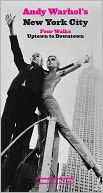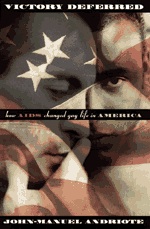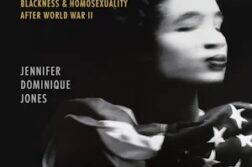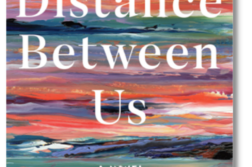Victory Deferred: How AIDS
Changed Gay Life in America
(Second Edition)
by John-Manuel Andriote
Booklocker.com. 746 pages, $25.95 (paper)
This landmark book, which was originally published in 1999, has been expanded here with dozens of new interviews with doctors, researchers, activists, and PWAs to coincide with the epidemic’s thirtieth anniversary. In the original edition, John-Manuel Andriote detailed the gay community’s transition from disenfranchised isolation to self-affirming political force even while coping with illness, death, and bigotry. Twelve years later, that urgency is tempered by the reality that HIV is now a chronic condition, while the gay rights movement has moved on to marriage equality and other issues. The book chronicles how gay men, facing indifference and contempt from the government and medical establishment, created their own organizations to deliver basic health care services, share information, and educate their own. These volunteer endeavors evolved into professionally run organizations with PWAs themselves playing a major role. At first, the gay community looked inward for financial support through private dinners, drag shows, dances, and silent auctions. Before long, wider communities joined in walkathons, raves, AIDS rides, and the like. In the bargain, however, AIDS service organizations were increasingly “de-gayed.” Andriote decries how these organizations, intent on self-preservation, fought over diminishing funding sources rather than merging or retooling services. Looking back, he describes how the confrontational tactics of ACT UP and the efforts of AmFar and the Human Rights Campaign resulted in revamped clinical trials for drugs, as well as a huge infusion of government funds. His presentation of the political struggles, the heroic actions, and the medical advances of the HIV era is a resonant reminder of the impact that personal and collective action can have.
John R. Killacky
 Andy Warhol’s New York City:
Andy Warhol’s New York City:
Four Walks, Uptown to Downtown
by Thomas Kiedrowski
Little Bookroom. 144 pages, $14.95 (paper)
Where was Andy Warhol’s Factory located from 1962 to 1968? Does it still exist? Other than the silver-painted interior, what was it like inside, and what did Warhol produce there? Independent scholar Thomas Kiedrowski, who leads the Andy Warhol Sites tours of New York, has the answers. Located on East 47th between Second and Third—the Factory was on the fifth floor—the building, which was once a cold storage facility and warehouse, was later torn down. A representative sampling of Warhol’s work came out of the Factory—the Brillo boxes, the flower paintings, many films, including Chelsea Girls, and a number of books. The eighty sites in Kiedrowski’s book—including galleries and museums, clubs where he hung out, and churches where he worshiped—are divided into four walks. Walk 1, for instance, is the Upper East Side above East 70th. The Andy-Mat, located at Madison and 74th, was to be the “first link in a proposed international chain of Andy Warhol fast-food restaurants,” what Warhol described as “the restaurant for the lonely person.” Sadly, the project fell apart before opening. We can imagine it, though, since architectural drawings are included. Well-illustrated with black-and-white photos, the book also contains charming works by Vito Giallo. Drawn using the same techniques as those he used as Warhol’s first paid assistant in the 50’s, Giallo’s handwritten captioning—“Empire State Building,” for instance, for the topic of Warhol’s eight-hour film Empire—echoes the style used by Warhol’s mother, who was called into service to write captions early in Warhol’s career. Giallo went on to own an antique store where Warhol shopped. In a July 2011 interview in Interview magazine, Giallo claims that he gave Warhol his first one-man show, at the Loft Gallery in New York, in 1954.
Martha E. Stone
 Tiny Terror: Why Truman Capote (Almost)
Tiny Terror: Why Truman Capote (Almost)
Wrote Answered Prayers
by William Todd Schultz
Oxford Univ. Press. 208 pages, $17.95
William Todd Schultz identifies himself as a psychobiographer, and the question at hand is: why did Truman Capote, who had for so long assiduously courted the “swans,” suddenly turn on his friends and destroy his social standing by writing the tell-all book Answered Prayers (published posthumously in 1987 but serialized in Esquire in 1975 and ’76)? The author goes in depth into Capote’s background: no parents to speak of; small-town childhood; no leg up; no college education. He was ambitious but also a meddler who enjoyed making mischief; and the resentment factor was always there. His mother committed suicide in 1954, and after that he always expected to be excluded and to be hurt. He thought he could be the Proust of his time, revealing New York society at mid-century in all its privilege, money, and scandal. But, his literary powers fading, he made it all seem like highbrow tabloid gossip, Fifth Avenue dish, and that only goes so far. Was he the Inside Guy that he wanted to be, or was he still, even with literary status and social éclat, the squeaky-voiced Southern queen from nowhere? Blame the ever-present alcohol and pills, but the silkier demons took over. Schultz explores many of Capote’s obsessions—for example, with Perry Smith, one of the murderers in In Cold Blood—as well as his neuroses, such his tendency to hallucinate and imagine burglars in his apartment. This is a fascinating look at a creative nervous breakdown.
John Mitzel






